October 4, 2023: After a rough start, I finally set off from Seven Seas Marina on my trip south for the winter on a perfect day.
The goal was to be on my way at 7 AM and I was probably on track to do that until I opened the engine lid to check the oil.
This is something I do religiously before every cruise. The oil is always okay. I’ve never needed to add any. But while I have the engine lid open, I also check other things, like the seawater intake strainer for engine cooling and the general condition of the engine compartment and bilge.
Bilge Pump Issues
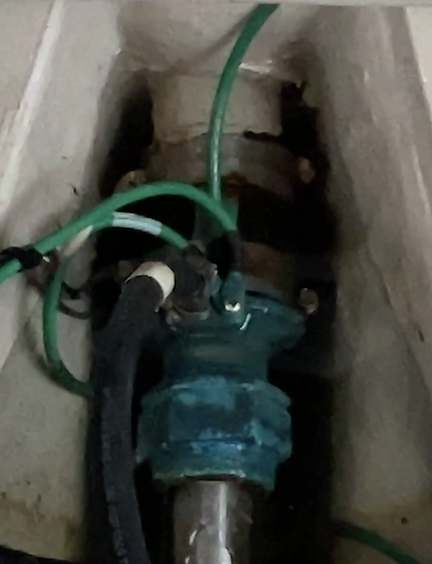
It’s not easy to see in this photo, but the drive shaft is completely covered with water. It shouldn’t be.
It was the bilge that stopped me in my tracks. There was at least 6 inches of water in there when there should have been less than an inch.
You might wonder how the bilge gets water in it in the first place. Well, there’s a packing nut where the drive shaft exists the boat to the prop. Ranger says that nut should drip once every 10 or so seconds. Sometimes it drips more, sometimes it drips less. But it’s definitely supposed to drip.
The bilge pump is set so it automatically runs every 6 minutes or so. There’s no float; it just goes on, pumps out any water it finds, and shuts off. It apparently wasn’t working.
I started troubleshooting by turning on the bilge pump. There’s a manual override switch at the helm; turning it on turns on the bilge pump until you turn it off. Nothing happened.
Not good. By this time, it was about 7:30 AM and one of the Ranger Tug sales guys from the Pocket Yacht company was walking down the dock. I asked him a few questions to make sure my understanding of how the bilge pump worked was correct. It was.
The maintance shop opened at 8 AM. I had a spare pump with me — bilge pumps are notoriously prone to failure — but if they had one in stock, I’d rather keep mine as a spare. And I definitely wanted them to swap it out.
(I should mention here that while I was running errands the day before, Frank, one of the maintenance guys, had been in the engine compartment to service the cooling system. Hadn’t he seen the water? Apparently, he had and he’d told my main contact at Seven Seas. She’d told me about it in an email message. But I don’t read my email regularly so I hadn’t seen it.)
But there was one more thing I could check: the fuse. Unfortunately, it was located in a cabinet in what Ranger Tug owners call “the cave”: a sleeping area under the dining table. I’d been stowing my unpacked boxes in there to get them out of the way. I needed to clear them away to get in there.
When I did, I discovered that the 7.5 amp standard auto fuse in the position marked Bilge #2 was blown.
By then, the maintenance and parts department was open. I told them about my issue and that I was going to try to replace the fuse. I had to buy one from the parts department. Well, I got two. And I actually swapped it for a light bulb, but that’s a long and boring story.
I went back to the boat and put in the new fuse. And I waited. And waited. I was just heading out to ask the shop to replace the bilge pump when it kicked in. I watched the water level in the bilge go down with the sound of water shooting out of the boat on the starboard side. The bilge pump kicked off when the water was gone.
Problem solved. I lowered the engine lid and got back to prepping the boat and my pups for departure.
Another Little Hiccup Before Departure

I use a standard inline RV water filter to filter the water that goes into my fresh water tank. (I still don’t drink it.)
The last big chore I had was to fill the fresh water tank. I’d been using as much water as I could to get the tank level down so I’d waited until the last minute. I wanted fresh water in there — not water that had been sitting in there since April. That meant setting up a pair of hoses to reach the water spigot and using my water filter to fill the tank. It took a long time. I worked on other things while it filled.
I removed the new canvas and screen panels that blocked access to the command bridge and gunwales. I was planning a fuel stop so I’d need access to the gunwales for docking. I secured my hanging fenders and made sure all my lines were set up the way I wanted them.
When the water tank was full, I drained and stowed the hoses and water filter.
I got my pups into their life jackets and put them up on the command bridge where we’d be riding during the day’s cruise. I also set up the chart plotter, autopilot, and radio up there. The weather was perfect. I was in shorts and a t-shirt in October!
I turned on all the electronics at the main helm and then started the engine.
I went back upstairs to check the thrusters, which I knew I’d need to get out of where I was parked. Nothing. They were dead.
Damn. What now?
I thought about how the Ranger Tug folks had shut off so many systems after installing my Garmin Black Box 800 AIS Transceiver. Had they shut off the thruster controls, too? Those switches were in the cave which was now quite accessible. I went down and checked. Sure enough, both switches were set to Off. I turned them on and went back upstairs. This time, they worked.
Nearby, the Pocket Yacht folks were delivering a 2024 R-25 to a couple. They’d introduced me as a solo Great Loop cruiser which had impressed the woman to no end. They were all busy on the new boat and no one seemed interested in helping me cast off. Fortunately, there was no current or wind in the marina. Not only was I able to cast off, but I had time to stow my lines before getting back onto the boat; it simply wasn’t moving.
Using a combination of reverse gear and aft thruster (mostly to to counteract prop walk), I backed the boat into a clear area. I spun the wheel all the way to the left and nudged it forward and then backwards to turn around with minimal thruster use. When I was pointed in the right direction, I headed out of the marina at idle forward speed.

I shot this photo as I left the marina.
It was my first time driving the boat in more than five months and I’d had no trouble getting out of a tricky parking area.
It was 9:50 AM.
Cruising to Fuel
The marina is on Kent Island in a very sheltered area called Crab Alley. I headed down Crab Alley Creek to Crab Alley Bay to Eastern Bay. The water was calm with just a tiny chop in a few places.
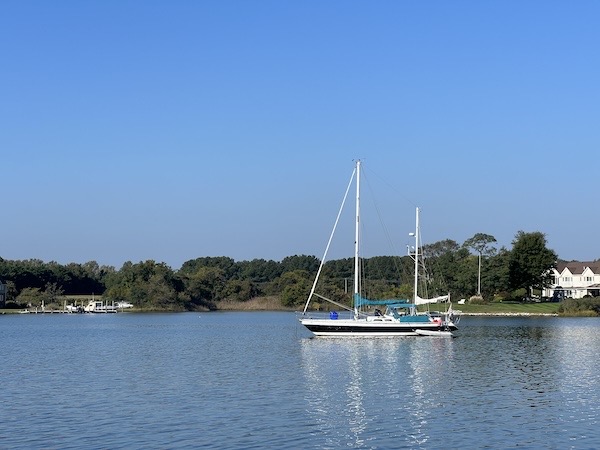
Here’s a sailboat at one of the Crab Alley anchorages. Peaceful!
I needed to go to Knapp’s Narrows Marina and Inn for fuel. One of the maintenance guys had told me it was on my way and the fuel was the same price as the marina I’d planned to go to across from Annapolis, which was definitely out of my way. Of course, I hadn’t planned the route in advance — I really just wanted to get going already — so I decided to let my Garmin AutoGuidance system plan it for me. It found the marina and plotted a course. There were hazards near the end — markers the route took me close to. I accepted the route and let Otto the autopilot drive while I supervised and kept an eye out for traffic, crab traps, and other obstacles.
Within 10 minutes, Otto, blindly following Garmins heavily faulted AutoGuidance route, was ignoring the channel and steering me into shallow water. Jeez. To be fair, my boat has just a 2 1/2 foot draft so it probably would have been okay. But why take chances? I turned off Otto and took control, leaving the course line on the chartplotter to keep me on track. For the remainder of the cruise, I used Otto’s Heading Hold and Go To features to steer the boat.
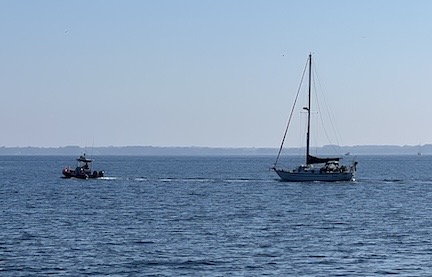
This guy was definitely having a bad day.
Did I mention that the weather was perfect? It was already in the 70s and the sun was strong, with just some clouds off on the horizon. I didn’t have the bimini top up and was well aware that I might get too much sun, but it felt good on my skin. Only a few days before I’d been dealing with real autumn weather at home that hinted about the cold weather to come. Now I had my own personal Indian summer.
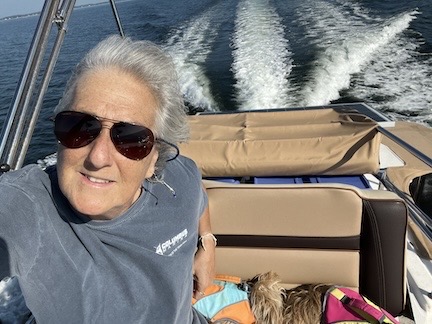
Here we are up on the command bridge, under way at speed. My pups are snuggled up on the seat beside me in their life jackets, already sound alseep.
There was hardly any wind and the water was crazy calm to the point where I could sometimes see schools of small fish, likely disturbed by a predator below, make tiny riffles on the surface. Other than that, the cruise was uneventful. I ran the engine at a variety of RPMs, getting up to 14 knots at one point. I played with the trim tabs and decided I needed to do more research to fully understand how to set them properly.
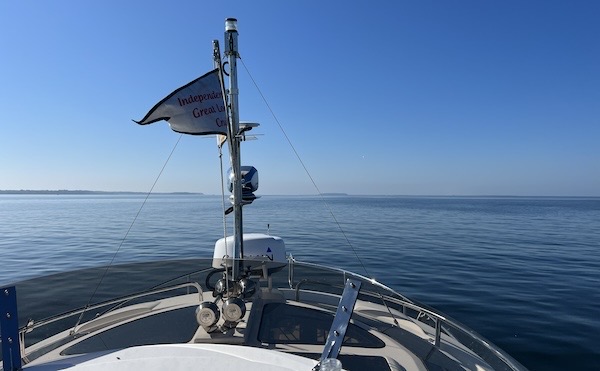
Can you imagine a more perfect day for cruising Chesapeake Bay?
We passed through an area with lots of crab traps and I slowed down to navigate between them. Although crab traps are dropped in straight line rows on the west coast of Florida, they’re randomly dropped here. A lot of the buoys have little flags while other buoys are home made from empty gallon (or larger) plastic jugs. I saw a lot of crabbing boats, as well as a handful of charter fishing boats. In general, however, there wasn’t much traffic on that October Wednesday.
It was about 11:30 AM when we reached the channel for Knapp’s Narrows. I slowed way down and turned into it. It was narrow indeed. Not much current, though.
I was within sight of the marina when I called in. The guy on the radio told me the fuel dock was right before the bridge and offered to come down to help me dock. I went wide, made a 180° turn, and came up with my starboard side right next to the dock. It was my first docking in five months and it went remarkably well. I came downstairs to help tie the boat off and the dockhand, an older guy, fueled me up.
The fuel was not as cheap as the maintenance guy at Seven Seas said it was. It was about 40¢ per gallon more at $4.32 per gallon, but still a lot cheaper than the $5+ I’d seen at a lot of other marinas. I took nearly 60 gallons.
I tipped the dockhand — heck, he’s the one who got diesel on his hands and he gave me a brand new diesel “diaper” when he got mine dirty — and got the girls off the boat for a pee break. The dockhand had recommended that I go under the bascule bridge there to continue on my way. Since I wasn’t familiar with the route — remember, I’d planned to go to a different marina for fuel — I spent some time with Aqua Map on my iPad and decided he was right; it would cut about 2 miles off my trip. I plotted out the new route on Aqua Map so I wouldn’t have to rely on my Garmin chartplotter’s AutoGuidance feature to get me there.
Continuing On Our Way
We were a bit rushed getting off the dock when another boat came in and wanted to park for fuel. I got us out into the channel and called the bridge, which had just closed. In the time we were there — maybe 30 minutes? — it had opened and closed at least six times. The operator told me he needed to get the traffic through and would open it shortly. I drifted a little in the channel and three other boats called. I finally heard the clanging bell as the bridge lifted and we all passed through.
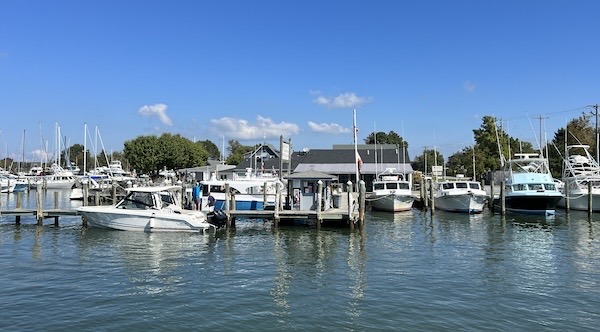
The fuel dock at Knapp’s Narrows Marina and Inn. I moved off the dock so that white boat could fuel.
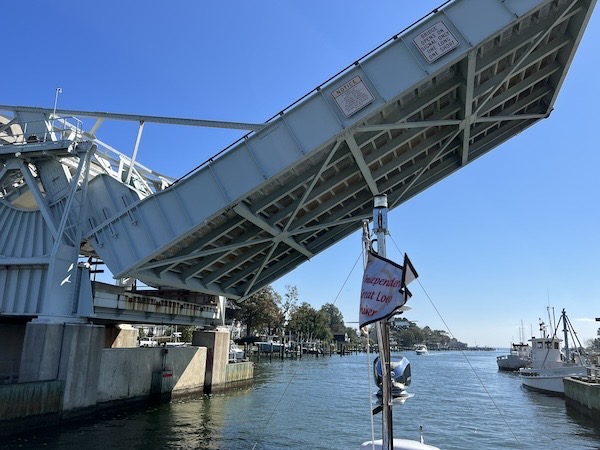
The bascule bridge at Knapps Narrows. Oddly, the sign on the bridge says it opens only on whistle signal, yet I didn’t hear a single whistle the entire time I was there.
We continued through the narrows and into the Choptank River where it meets Chesapeake Bay. We were only 12 or so miles from the anchorage now. I let Otto drive the boat, utilizing both the Heading Hold and Go To features. There were hardly any other boats or crab traps. The water was even smoother here than it had been earlier in the day. It was easy going. We cruised at a good clip covering the distance in just over an hour.
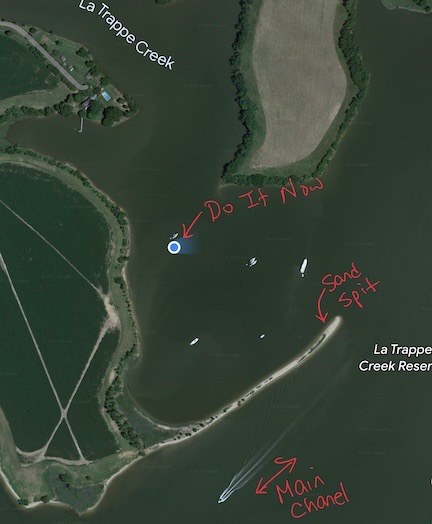
Here’s a Google satellite view of the anchorage. It was very sheltered.
Soon we got close to the narrow channel we’d have to turn into to get to the anchorage. There were two huge channel markers and I knew from my chartplotter info that I’d need to thread my way between them carefully since it was nearly low tide and the water outside the channel was shallow at the entrance.
I wound my way into La Trappe Creek, past the sand spit that separated the anchorage from the creek. I was disappointed to see No Trespassing signs on most of that sand spit — which is where I’d hoped to take my dogs for their pee breaks — but glad to see that there weren’t any at the very tip of it. Maybe that part wasn’t private property? I suspect the signs were there to prevent the usual weekend partiers from gathering on the spit with their loud boats, louder radios, and beer can trash.
Dropping Anchor
There was a smallish fishing boat in the anchorage with four people on board. They were anchored, but I didn’t expect them to spend the night. I drove past them slowly, moving farther into the cove. Then I bought the boat to an almost stop, came out to the bow, and used the windlass to lower the anchor with about 25 feet of chain.
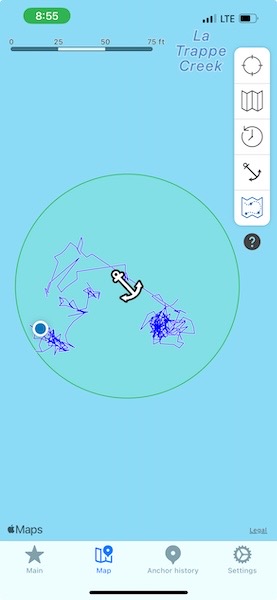
Here’s Anchor Pro’s map of where I spent the night in relation to the anchor. I was to the east at low tide and to the west at high tide, which is where I am in this screenshot.
I waited. The water was about 8 feet where I was and would rise another foot or so as the tide came in. I went back up to the command bridge and gently nudged the boat backward to maybe set the anchor. Honestly, I’m so accustomed to anchoring with a current or wind to push the boat back that I was at a loss on how to do it with neither. Then I went down and dropped another 15 or so feet of chain. That would give me an a good 3:1 rode, including the distance between the bow of the boat and the bottom of the water at high tide. I killed the engine and set an anchor alarm. I could always let out more rode if I needed to.

Here’s my Nebo log for October 4, 2023. Download a PDF log file with more info. Track Do It Now on Nebo.
Anchorage Chores
I took care of chores: stowing equipment on the command bridge, covering the Garmin displays, bringing down everything I didn’t want to leave on the command bridge overnight — which is pretty much everything that isn’t fastened down. On the coast, where there’s a lot of moisture in the air, condensation covers everything in the early morning hours, leaving uncovered items drenched. I didn’t want to start the next day’s cruise with soaking wet log sheets or dog blanket.
Then I launched the dinghy. The new davit system was a dream to operate; I had the boat in the water and tied up to one of the dinghy cleats on the swim platform within minutes. And no lugging that 46-pound engine around or fears of dropping it in the water!
I had a heck of a time getting the engine started. Maybe I had drained all the fuel out before I left for the season because I had to add fuel before it would start. I think pulling that cord repeatedly will be my arm exercises for the next few months.
I gathered the girls, who were still in their life jackets, and got them on board. Then I motored us over to the far end of that sand spit, where I hadn’t seen any signs. I was armed with poop bags so the only thing we’d leave behind were footprints.
At Anchor
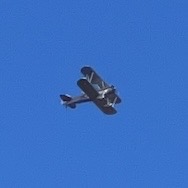
This guy flew by trice in the afternoon.
Back at the boat, I spent some time neatening up the cabin, doing my morning dishes, and unpacking a box. It was warm in the cabin and I thought about all those people with air conditioning on their boats and how they’d likely be hunkered down inside with the AC and generator running. I had the boat wide open to the breeze and listened to the sound of birds, and the occasional passing boat or plane.
The fishermen left and I considered moving the boat closer to the spit. But since it was holding where it was, I just stayed put.
After a while, sailboat came in and dropped anchor closer to shore and the spit. We’d be joined by a bigger, fancier sailboat at sunset; he anchored between me and the spit. We were all quiet; no music or loud talking.
I made a late lunch, ate half of it, and stowed the rest for leftovers. Another fishing boat came in and dropped anchor between me and the sailboat. Much later, I fed my pups and took them back to the sand spit to do their business. A couple in a canoe paddled by us. The fishing boat left.
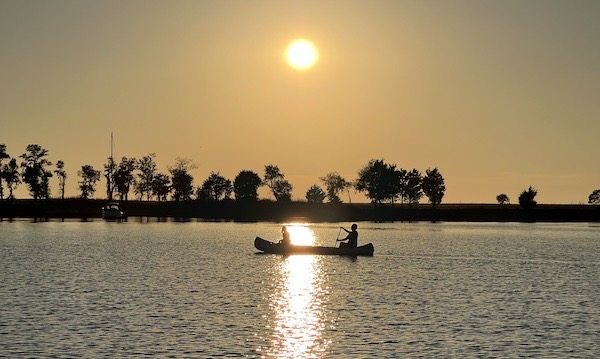
It was nearly sunset when I took my pups for their last pee break and this canoe paddled by.
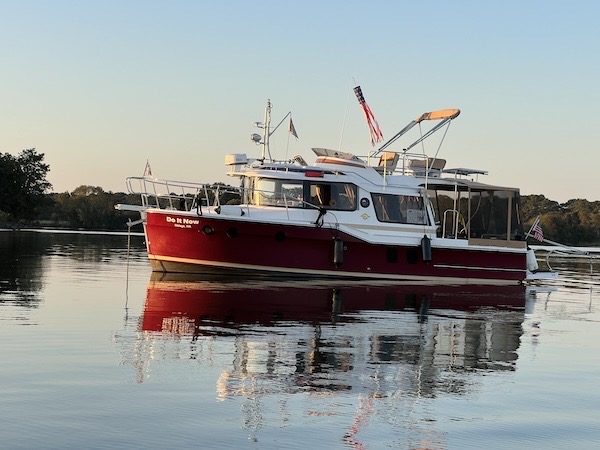
On the way back to the boat, I took a photo of it at anchor.

A martini up on the command bridge.
I had a martini at sunset up on the command bridge. Gin this time. (Note to self: you don’t need to fill the martini glasses.) I hung out for a long while out there. The larger sailboat had just come in and dropped anchor. They had their anchor light on and that reminded me that I needed to turn on mine, too. Theirs was so high up that when I woke up in the middle of the night to take a look around, I thought it was a very bright star.

My neighbor’s sailboat is a real beauty.
I spent some time out on the aft deck, inside my new screened enclosure. I had set up the table earlier in the day. I made myself some Progresso soup and ate it out there. I was in power saving mode so I used the stove and only lit the cabin with the low-light LEDs, preferring a solar powered camping light for the aft deck. My pups joined me on the bench seat when they realized I wasn’t coming back to bed.
It was wonderfully peaceful and quiet. I started wondering why I’d spent so much time at sometimes costly marinas in the spring when I could have enjoyed a more pleasant overnight spot.
It was nearly eight when I finally went in for the night. I settled down in bed, turned on the TV with Roku, connected it to my phone’s hotspot, and watched the last episode of Ahsoka on Disney Plus. (Being at anchor doesn’t mean being totally disconnected.) It was just after nine when I turned off the TV and went to bed.
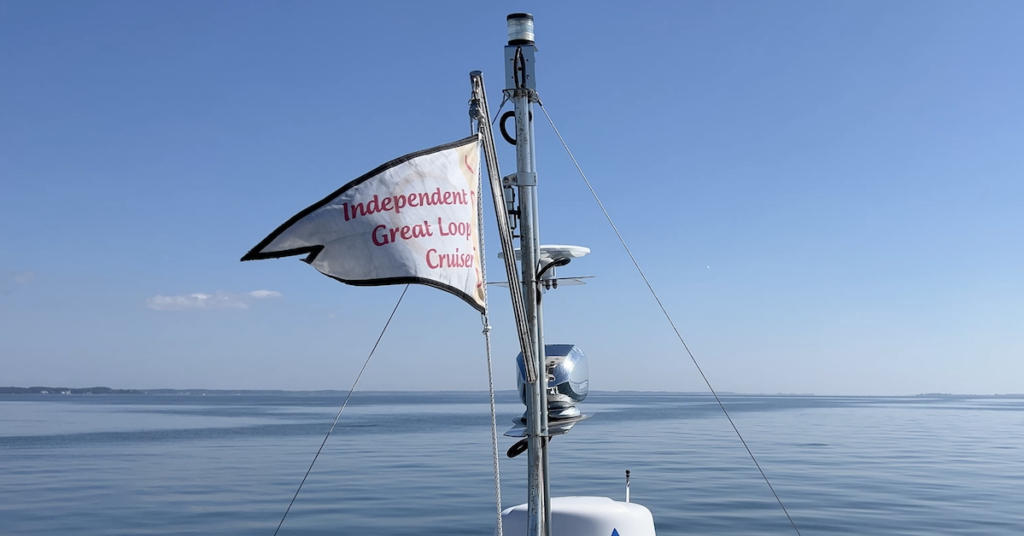
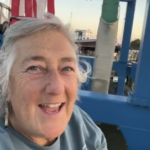
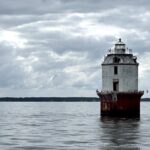
That martini looks delicious!!
It was! But way bigger than I needed it to be.